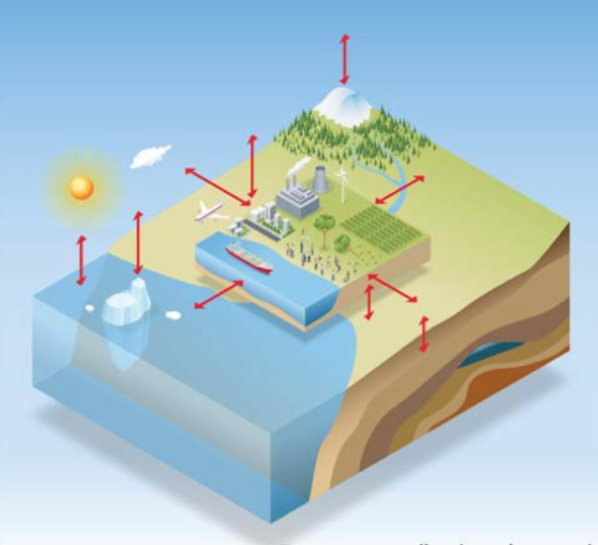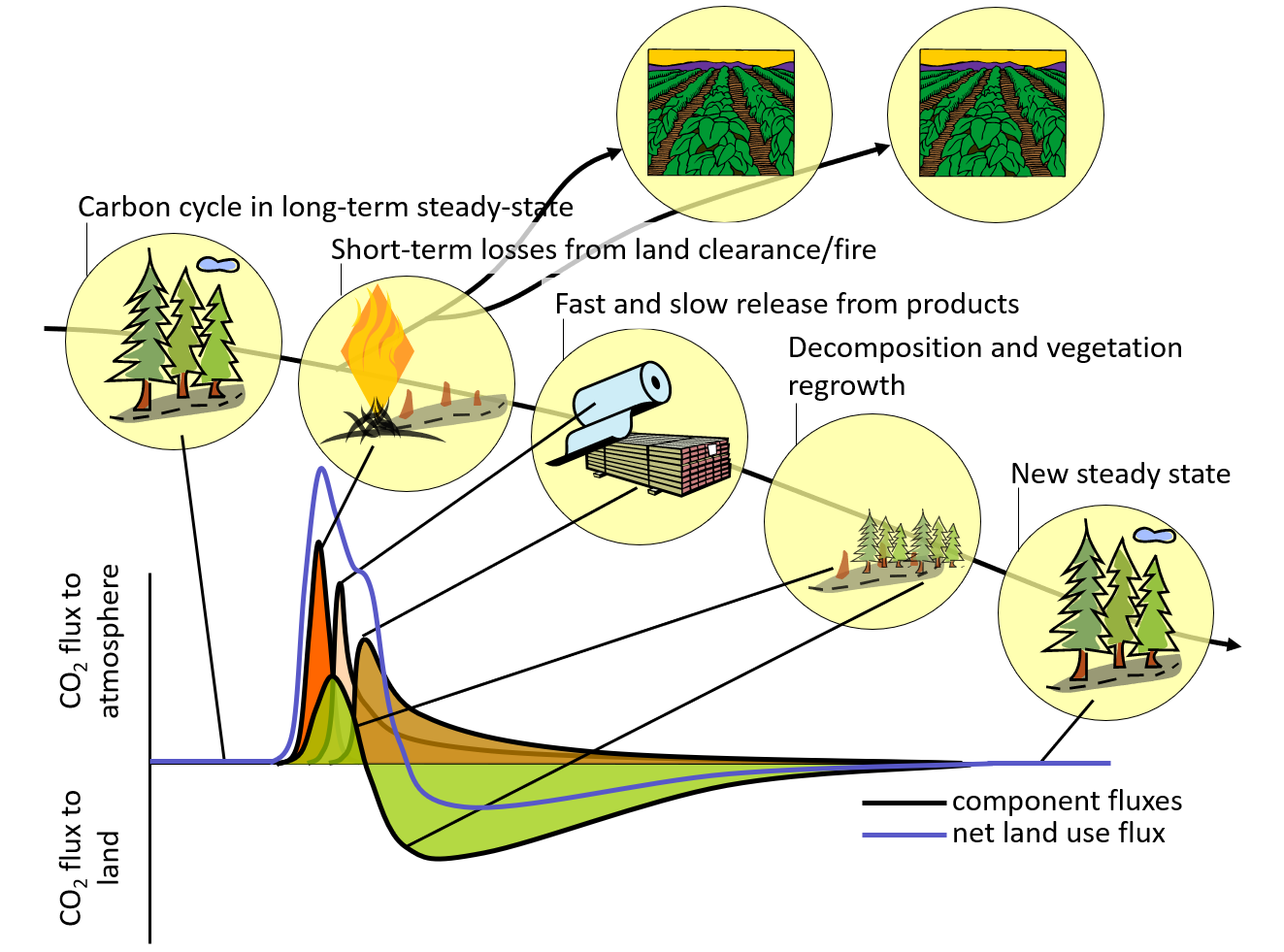NGD Land and Energy
Land and Energy Model Development
This research flows directly from (and aims to fundamentally improve) scientists’ ability to address the E3SM v3 science questions, and targets specific weaknesses and gaps that limit researchers’ ability to address the v3/v4 model science questions.
The Land and Energy NGD (“Next Generation Development”) subproject aims to significantly improve the performance of E3SM’s Land Model (ELM) in the next five years.
Coupling Between the Human (GCAM) and Earth System (E3SM) Models

Schematic of transfers (in carbon, water, etc.) between human industrial/agricultural systems and the larger Earth system.
Predicting future changes in Earth’s water cycle, biogeochemical cycles, and cryospheric processes requires handling interactions between natural and human systems, i.e. feedbacks due to land use, energy production, and industrial emissions. The strength of these feedbacks is still largely unknown (Calvin and Bond-Lamberty, 2018). The ELM team is thus focusing on improving the representations and interactions of human activities and terrestrial processes in E3SM.
First, interactions between the GCAM integrated assessment model and the E3SM water system will be strengthened by exchanging water supply and demand information, including potential effects of agricultural activity on water biogeochemistry. The team is modifying the existing GCAM-E3SM coupling to use the native ELM crop model, which provides direct estimation of specific crop yields.
For interactions between GCAM and ELM’s new dynamic vegetation scheme (FATES, Holm et al. 2018; see below), the team is expanding the coupling to communicate effectively with FATES, and improving the information exchange between GCAM and ELM. A number of improvements to the ELM crop model will also occur: new crop types; new management practices; and additional phenological stages of crop development that stress factors such as temperature (heat and freeze), water, and nitrogen.
Finally, coupling of ELM with the crop model and MOSART will be improved to better represent the impacts of crop management and water management on streamflow, stream temperature, floodplain inundation and river biogeochemistry.
Hydrology and Plant Hydraulics
Hydrology and plant hydraulics (hydrodynamics) and their responses to environmental variations and changes are fundamental drivers of terrestrial water, carbon, and nutrient cycles, affecting plant growth and mortality (McDowell et al. 2011). For example, lateral subsurface flow strongly influences land-atmosphere interactions and water availability, as well as a wide range of physical, chemical, biological, and human processes in the terrestrial system. However, land surface models such as ELM typically ignore such processes, and only crudely simulate the integrated effects of hydrology-plant dynamics.
Currently, FATES has carbon starvation as the main mechanism of mortality but the interaction between carbon starvation and hydraulic failure could be the most important mechanism for predicting mortality (see e.g. Sevanto et al. 2013). The team is developing mechanistic linkages between hydraulics and carbohydrate dynamics to simulate their interdependencies and subsequent impacts on the water and carbon cycles and on vegetation dynamics, and will expand the current ELM plant functional types to consider plant hydraulic- and carbon-based strategies through integration of global trait-databases with FATES.
To represent the impacts of lateral processes on soil moisture and evapotranspiration important for local recycling, the team is comparing two approaches that use spatially interacting hydrologic response units and hillslope resolving models to represent lateral subsurface flow, based on the work of Maquin et al. (2017) and Hazenberg et al. (2015). These will be implemented in the topography-based subgrid structure of ELM by mapping the subgrid lateral fluxes at hillslope scale to the subgrid topographic land units. This enables realistic representations of lateral flow processes and their impacts, while keeping the amount of additional computational cost minimal.
E3SM already represents lake hydrodynamics and sediment biogeochemistry, river routing and inundation, and wetland biogeochemistry. Some efforts have been devoted to modeling soil erosion and riverine carbon. To represent terrestrial-aquatic interactions, the team will introduce two-way exchanges of water, carbon, and sediment fluxes between the land-surface and freshwaters (rivers and lakes) via the floodplains, which include wetlands, and a new hyporheic zone.
Natural and Anthropogenic Disturbance

Theoretical response of land-atmosphere carbon exchange to different factors after a managed (human) disturbance. Over a long period of time, the perturbed landscape returns to its previous state.
Fires and other disturbances exert large effects on the terrestrial and atmospheric components of the earth system (Le Quéré et al. 2018). The current E3SM implementations of managed (e.g. harvest and forest-to-pasture conversion) and unmanaged (fire) disturbances have significant shortcomings. This is a significant problem, as these disturbance impacts play a substantial role in decadal and century-scale land-climate system feedbacks.
The team is improving the realism of the fire model and simplifying its structure by more effectively using new satellite observations of fire number and fire size from Version 4 of the Global Fire Emissions Database (van der Werf et al. 2017). The model now allows fire duration and spread rate to vary as a function of surface meteorology, vegetation type, and fuel status, and includes negative feedbacks from intersecting fires. The number of free parameters describing fire behavior will be reduced by about a factor of approximately two.
The team will also focus considerable attention on managed disturbances in the model. The single soil column currently used in ESM will be replaced by a vector of columns, with predefined binned values for time-since-disturbance for each column; exact bin boundaries will be optimized to represent dominant modes of variability for common large disturbances. This work will support the new ELM crop implementation (see above).
Vegetation Dynamics, Canopy Processes, and Photosynthesis

Sunlight striking a plant canopy triggers fluorescence in the leaf’s photosynthetic machinery, a radiation emission that can be detected from space.
Global terrestrial vegetation plays a critical role in biogeochemical cycles (Ahlström et al. 2015), and has been altered by anthropogenic global change drivers including land-use change, altered disturbance regimes, invasive species, and climate change. Vegetation and ecosystem productivity originates from canopy photosynthesis, but the current ELM photosynthesis module was developed more than two decades ago, and several important advances in understanding of the underlying processes have emerged since. These model deficiencies now limit accurate representation of land-atmosphere interactions necessary to address the v3 science questions.
Developers are introducing a land-cover change capability in ELM-FATES by defining an interface for passing scenarios into FATES from in situ observations, remote sensing based products, integrated assessment models, and other data sources. This interface will also return data from FATES to ELM. For example, FATES’ transition functions transform primary vegetation into land use classes for ELM. Evaluation datasets for this work are drawn from existing vegetation databases such as TRY, AmeriFlux and FLUXNET, and other sources.
In further work, scientists are evaluating the v1 model’s leaf-scale behavior against extensive databases of leaf-scale water, energy, and CO2 fluxes. This will enable researchers to (1) improve the representations of photosynthesis acclimation to warming and CO2, investigating and implementing concepts of nitrogen and phosphorous regulation; (2) investigate and implement new approaches to relate conductance, assimilation, and hydraulics (Rogers et al. 2017); and (3) refine the numerical integration scheme.
Finally, the ELM land team aims to improve the representation of solar-induced chlorophyll fluorescence, enabling evaluation against new multi-scale observational constraints. The team will also implement canopy structural and functional improvements based on variations in leaf biochemical processes, evaluating the impact of these changes on global water flows and linking with the hydrology work described above.
Summary and Relationship of This NGD to Other NSG Projects
These ongoing developments will improve E3SM’s estimates of forcing factors, strengthen the representations of crops and crop/water management, and deepen scientists’ understanding of how Earth system changes affect energy, land, and water systems.



